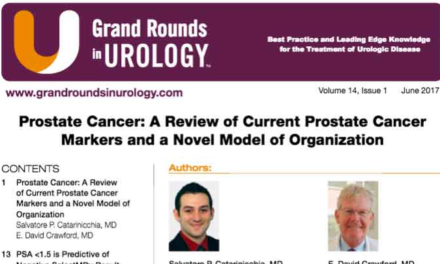Dr. Gerald L. Andriole, Jr. presented “The “Who’s” of Genomic Markers: Who to Treat” at the 27th annual International Prostate Cancer Update meeting on Wednesday, January 25, 2017.
Keywords: prostate cancer, metastasis, genomic markers, prolaris, prostatectomy, biopsy
How to cite: Andriole, Gerald L. “The “Who’s” of Genomic Markers: Who to Treat.” January 25, 2017. Accessed Dec 2024. https://dev.grandroundsinurology.com/whos-genomic-markers-treat
Transcript
The “Who’s” of Genomic Markers: Who to Treat
Everybody has seen this, talked about it, conventional biopsy, completely misleading. We don’t have to beat that any further. And so if you really want to know if the guy in front of you actually needs treatment, you might want to turn to some other tests, and there’s some immuno-histochemical tests, there’s Prolaris, Oncotype, Promark test and Decipher. And just a shout-out to PTEN, it’s cheap, it’s not commercialized, it can segregate between lethal, or very lethal, and less than lethal prostate cancer. These immunohistochemical markers, including PTEN and KI67 were looked at by the NCCN guidelines panel and basically not recommended because they’re there’s some heterogeneity in how the study tests are done and interpreted, but there probably is some truth there. And if you had a boutique pathologist who could do a good job they might actually be helpful for you.
Okay, what about the genetic tests, the Prolaris test, 31 genes involved in the cell cycle progression, mRNA levels using quantitative PCR are scores developed from fixed tissues. The earliest studies now about 25 years ago in men who underwent a TURP, had cancer detected, treated conservatively, you can see how their prostate cancer specific mortality segregated on the basis of their score. And this study was sort of replicated in men diagnosed on a needle biopsy and conservatively managed, again, in the early PSA era. And you can see, again, that the score correlated with the 10-year probability of prostate cancer mortality. This was validated at UCSF, Matt Cooperberg and colleagues, showing that for men with low-risk disease on the basis of score you could stratify their risk of prostate cancer mortality.
Here’s an example of the Prolaris report. I’m sure many of you have seen this, describing the man’s risk of mortality and how aggressive it is in comparison to men with other similar clinical characteristics and pathological characteristics.
The information you get is actionable. This is a decision impact trial where the treating physicians felt that about a third of their diagnosed cases should be monitored, and about two-thirds treated; however, after the results of this test were made to them and the patient only a quarter of the patients were deemed to require intervention. You could see the changes. A quarter of the men who were to have non-intervention were then determined that they should warrant intervention, and 15% of the patients deemed to warrant therapy before the test was known were not offered therapy because of the reassurance from the Prolaris score.
Prolaris can also be used, and we’ll talk about this about this a little bit later, to determine whether a man who’s had some adverse pathological findings on a radical prostatectomy warrants early adjuvant radiation therapy, versus monitor him for later progression. The NCCN guidelines panel looked at Prolaris and recommended it in the scenario to determine whether treatment is necessary for men with newly diagnosed prostate cancer.
Another genomic test is the Oncotype DX GPS score. These slides were given to me by Alan Shindle, a former resident of ours who now works with Genomic Health, so there’s some animation here that shows how they threw a lot of genes into a funnel and out of that funnel came 17 GPS genes in this test. Very similar to the Prolaris test, knowledge of the GPS score even within NCCN risk classification, so very risk patients, low-risk patients and intermediate-risk patients show different probabilities of harboring aggressive disease.
This is a GPS score. Now, this is reporting not mortality, the ten-year mortality from prostate cancer, which is what the Prolaris score is reporting, this is reporting the probability that this individual who harbors Gleason 6 disease on biopsy actually has favorable pathology and/or harbors Gleason pattern 4 and 5 cancer that was undetected. And you can see on a histogram where this person’s GPS score ranges in comparison to other men with similar clinical characteristics.
This was also looked at by the NCCN guidelines panel, and is also recommended to help make the decision between surveillance and intervention. Similar to the data I showed you from the Prolaris study on decision impact trial, you can see that with the knowledge of the patient’s GPS score, a higher proportion of men in the low-risk category were deemed to be appropriate for active surveillance. The same was true for low-risk and intermediate-risk disease.
How about the Promark, this isn’t really a genetic test, this is a quantitative expression of 8 proteins that can be measured from the biopsy. These proteins predict the tumor aggressiveness independent of the clinical and pathological variables, but the report you receive is a combination of the information from those 8 proteins, as well as the clinical variables. This the initial validation study. And you can see that the Promark score has a very, very robust probability of differentiating favorable pathology from unfavorable pathology for men who underwent a radical prostatectomy. Similar to what was shown for the Prolaris and the GPS tests, there’s a lot of heterogeneity even within a given risk category, so NCCN, very low-risk clinical tumors. You can see some of them were very unfavorable when the Promark score was known.
And this is a look at a Promark report. And again, it tells you the probability that if the patient is deemed to have a clinically low-risk tumor here’s his probability of having unfavorable pathology at a radical prostatectomy. And again, you can see where that individual patient’s score sits in comparison to other patients evaluated with the test.
Finally, the Decipher genomic signature is available. The initial studies have been undertaken to predict the development of metastases in patients who have had a radical prostatectomy. So you can see that the genomic classifier predicts the probability of metastases in men who’ve had a radical prostatectomy, with the high-score patients having a much higher probability of metastases on followup. Furthermore, you can see that men with a very low genomic classifier score do just as well whether they receive adjuvant or salvage radiation therapy; whereas, a men who has had a radical prostatectomy who has a high genomic classifier score, if you wait to administer salvage prostatectomy he will not do as well as the cohort of patients who had received adjuvant radiation therapy. So this is a very robust way of determining which patients need early adjuvant aggressive radiation therapy after a radical prostatectomy.
Similar to the other decision impact trials, you can see how knowledge of the genomic classifier result changed clinical decision making for these patients.
Here is a look at the Decipher report classifying the probability of metastases within the next five years, and giving you a sense of where your patient’s score is in relation to the other cohort of patients. I actually like this. You get these reports periodically from the company. I sent a man who had a Gleason 4 plus 3, high-volume radical prostatectomy and I wanted to know if I should use salvage radiation or adjuvant radiation therapy. And you can see that he was in an intermediate group, but actually relatively favorable when compared to all the other men with that type of pathology.
The Decipher test has also been looked at in biopsies for its ability to predict later metastases, and it does. But thus far, at least to my knowledge, the studies are rather small. And you can see here there’s only 57 patients that within a given a NCCN risk group the Decipher score can be segregated into low, intermediate, or high. I would say that just eyeballing this it bothers me a little bit that some of the men who developed metastases, while they were NCCN high risk, but the test, the Decipher score was considered low; nonetheless, he developed metastases. And you can see that I guess only two of the five patients who were considered in the high-risk group ultimately developed metastases. But it’s a very, very small study and I’m sure we’ll be hearing more about that in the future. And again, the Decipher test was looked at by the NCCN guidelines panel and is recommended to help make the decision between adjuvant and salvage radiation therapy.
I’ll call to your attention the fact that there’s a lot of genetic variability in prostate cancers. You know, many men who have a radical prostatectomy harbor multiple tumors. I guess the average is between 6 and 7. And if you perform these individual tests on each of those tumors you may actually get different results. And furthermore, the same tumor evaluated by each of these different tests may score differently. So we really are at the very early stages of understanding how to use these tests. And I’m hopeful that at the panel discussion later we can maybe vet this chart that Eric Klein has been recommending, and how to use these tests to determine which patients need treatment, and which is most appropriate. I think that it’s best to reserve that for the panel discussion later.
Thank you very much for your attention.
ABOUT THE AUTHOR
Gerald L. Andriole, Jr., MD, is the Robert K. Royce Distinguished Professor and Chief of Urologic Surgery at Barnes-Jewish Hospital, the Siteman Cancer Center, and Washington University School of Medicine in St. Louis, Missouri.
Dr. Andriole received his medical degree from Jefferson Medical College in Philadelphia, Pennsylvania. He trained in surgery at Strong Memorial Hospital and the University of Rochester and completed his Urology Residency at Brigham and Women’s Hospital and Harvard Medical School. Subsequently, he was a Fellow in Urologic Oncology at the National Cancer Institute in Bethesda, Maryland.
Dr. Andriole has over 35 years of consistent contributions in the areas of BPH and prostate cancer screening and prevention research. He has contributed well over 400 peer-reviewed publications and serves on the editorial boards of several prestigious journals. He is Chairman of the Prostate Committee of the National Cancer Institute’s Prostate, Lung, Colorectal and Ovarian (PLCO) Cancer Screening Trial, and PI of the NIDDK Multidisciplinary Approach to Urologic Pelvic Pain (MAPP) and Symptoms of Lower Urinary Tract Dysfunction Research Network (LURN). He was Chairman of the Steering Committee of the REDUCE Prostate Cancer Prevention Trial, as well as PI of both the NIDDK Medical Therapy of Prostatic Symptoms (MTOPS) BPH trial and the NIDDK Complementary and Alternative Medicine for Urinary Symptoms (CAMUS) study. He is a member of the American Urological Association, the American Association for Cancer Research, the American Society of Clinical Oncology, the American Surgical Association, the American Association of Genitourinary Surgeons, and the Clinical Society of Genitourinary Surgeons, among other societies.





